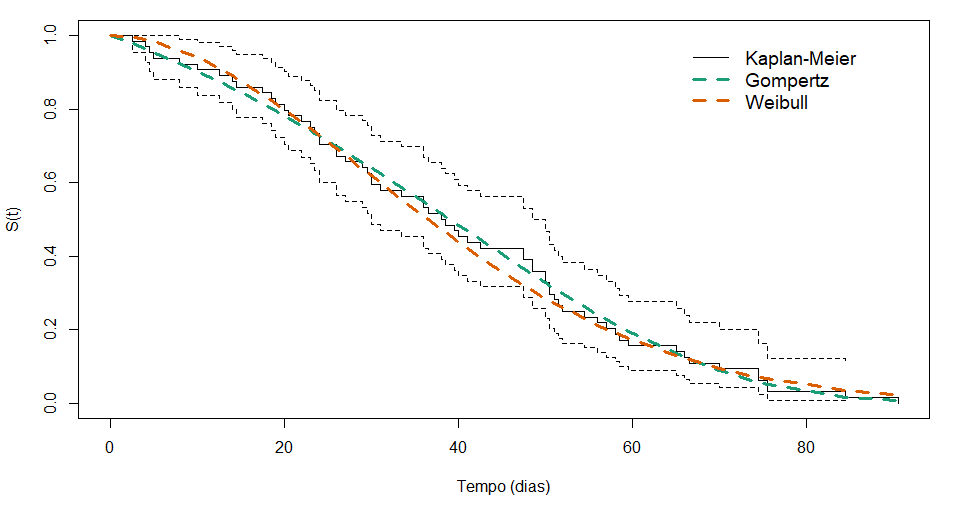Identification of risk factors associated with the performance of Canchim bulls, in confinement, using the theory of survival analysis
Keywords:
Canchim, Confinement, Cox ModelAbstract
The study of the performance of beef cattle in confinement has aroused a lot of interest and is growing in Brazil due to these animals being in a controlled environment, facilitating the measurement of performance parameters and feed efficiency with daily collections, which results in more accurate data. Associated with this, this practice also provides animals with greater weight gain in a shorter period of time, making it a more profitable option for slaughterhouses and producers. Therefore, the objective of this work was to analyze the time it takes for Canchim bulls to achieve a daily weight gain of 1.2 kg during a period of confinement, as well as the possible factors that may affect this time. For this, a survival analysis approach using non-parametric techniques and the parametric Cox model was considered. The parametric Cox-Gompertz model considering the covariate birth weight (PI) presented the best fit to the data, that is, within the set of covariates adopted for analysis, this variable had an important influence on the time for the animal to reach the desired weight during the confinement period; a low birth weight contributed to better performance.
References
ABIEC. Perfil da Pecuária no Brasil. Beef Report: São Paulo, 2019. Disponível em: url{http://abiec.com.br/Sumario2019.aspx. Acesso em: 10 de abr. 2023.
AKAIKE, H. Information theory and an extension of the maximum likelihood principle. In Second International Symposium on Information Theory (Edited by B. N. Petrov and F. Csaki), p.267-281. Akademiai Kiado, Budapest, 1973.
CAETANO, S. L. Estudo da idade da vaca ao último parto para avaliar longevidade em rebanhos da raça nelore por análise de sobrevivência. Tese de doutorado - Universidade Estadual Paulista, Faculdade de Ciências Agrárias e Veterinárias, 2011.
COLOSIMO E.A.; GIOLO S.R. Analise de Sobrevivência Aplicada. Editora Blucher, 2006.
COX, D. R. Regression models and life tables (with discussion). Journal of the Royal Statistical Society, Series B; 34:187 - 220, 1972.
COX, D. R.; SNELL, E. J. A general definition of residuals. Journal of the Royal Statistical Society: Series B (Methodological), 30(2), 248-265, 1968.
CUNHA, E. E., MELO, T. P. Analise de Sobrevivência Não-Paramétrica da Idade ao Primeiro Parto em Fêmeas Nelore: Um Estudo de Simulação. Revista Brasileira de Biometria. São Paulo, 30 (3), 305 - 325, 2012.
DEUS, B. M. M. de; FERREIRA, E. J. P.; BARRA, M. M. Confinamento, uma alternativa para alavancar lucratividade: Compapi Fazenda Santa Adélia. Monografia - Centro Universitário Católico Salesiano Auxilium - UNISALESIANO, Lins-SP, graduação em Administração, 2009.
GIOLO, S. R., HENDERSON, R., DEMÉTRIO, C. G. B. Um critério para a seleção de touros nelore usando modelos de sobrevivência. Rev. Mat. Estat., São Paulo, 21(3), 115 - 123, 2003.
KAPLAN, E. L. E MEIER, P. Nonparametric estimation from incomplete observations.Journal of the American statistical association, 53(282):457–481, 1958.
LAWLESS, J. F. Statistical models and methods for lifetime data, volume 362. John Wiley & Sons, 2011.
LIMA, Cleide Mayra Menezes et al. Modelo de Cox-Gompertz para análise do tempo de permanência em um rebanho de cabras da raça Anglonubiana. Semina: Ciências Agrárias, v. 42, n. 5, p. 2937-2958, 2021.
MOORE, D. F. Applied survival analysis using R. Springer, 2016.
R CORE TEAM. R: A Language and Environment for Statistical Computing. R Foundation for Statistical Computing, Vienna, Austria, 2023.
SCHWARZ, G. et al. Estimating the dimension of a model. The annals of statistics, 6(2):461–464, 1978.
SUN, F. B.; KECECLOGLU D. B. A New Method for Obtaining the TTT Plot for a Censored Sample. Proceedings of Annual Reliability and Maintainability, p.112-117, 1999.

Downloads
Published
How to Cite
Issue
Section
License
Proposta de Política para Periódicos de Acesso Livre
Autores que publicam nesta revista concordam com os seguintes termos:
- Autores mantém os direitos autorais e concedem à revista o direito de primeira publicação, com o trabalho simultaneamente licenciado sob a Licença Creative Commons Attribution que permite o compartilhamento do trabalho com reconhecimento da autoria e publicação inicial nesta revista.
- Autores têm autorização para assumir contratos adicionais separadamente, para distribuição não-exclusiva da versão do trabalho publicada nesta revista (ex.: publicar em repositório institucional ou como capítulo de livro), com reconhecimento de autoria e publicação inicial nesta revista.
- Autores têm permissão e são estimulados a publicar e distribuir seu trabalho online (ex.: em repositórios institucionais ou na sua página pessoal) a qualquer ponto antes ou durante o processo editorial, já que isso pode gerar alterações produtivas, bem como aumentar o impacto e a citação do trabalho publicado (Veja O Efeito do Acesso Livre).
